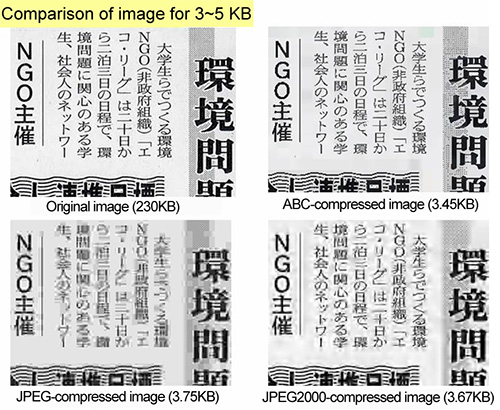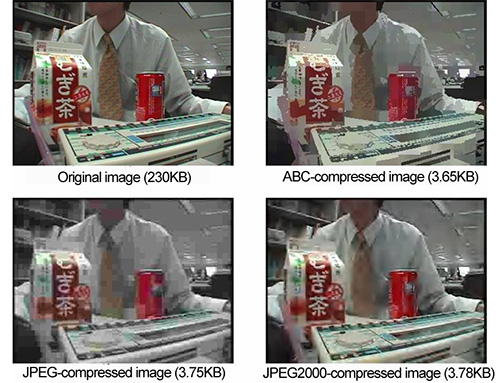The Advanced Semiconductor Research Center (ASRC) of the National Institute of Advanced Industrial Science and Technology (AIST), an independent administrative institution, has developed in collaboration with the Tsukuba Medical Center Hospital (TMCH) and the Tsukuba City Fire Department (TCFD) under the Urban Area Tripartite (Industrial-Academic-Governmental) Collaboration Promotion Program of the Ministry of Education, Culture, Sports, Science and Technology (MEXT), a system named "In-Ambulance Remote Image Acquisition System" which allows doctors sitting in the emergency ward to monitor images, both moving and still, of medical scenes within an ambulance rushing back to the hospital, through their own camera operation. The system is expected to contribute to upgrading lifesaving performance of the emergency medical service requiring prompt treatment.
In the emergency medical service, success in lifesaving is greatly affected by the treatment provided in the ambulance while hurrying from the accident scene to the hospital, as well as the preparation at the emergency ward. For this reason, it is highly desirable to develop an image transfer system through which doctors in the hospital can acquire images of the patient in the course of transit under their own control.
The "In-Ambulance Remote Image Acquisition System" developed by the ASRC-AIST in collaboration with TMCH and TCFD is to transmit image of a patient in an ambulance by a mobile phone to the emergency ward via a provider's network, for prompt diagnosis by standby doctors, and/or giving instructions to paramedic. The mobile communication via cellular phone may have available data amount largely affected by buildings or terrain, or by traffic conditions. To secure image quality needed for doctor's diagnosis even under unfavorable data traffic, a new data-compression technology has been developed "Adaptive Block Truncation Coding (ABC)" for mobile communication. The data compression through the adaptive BTC (ABC) is characterized by better quality and smaller data size than those for still image data, JPEG and JPEG2000 within the capacity of mobile phone. It ensures sending image data within a shorter time period and suppresses errors in radio transmission in comparison to other data compression formalities.
For the "In-Ambulance Remote Image Acquisition System", the priority aim of development has been not to simply transmit scenes within an ambulance, but to provide selectively images really required for the medical treatment. An intuitive user interface has been developed in collaboration with doctors in TMCH where the doctor has only to click an area on the PC screen for viewing details without resorting to complicated camera works. The doctor would be able to view high precision still image with a high-speed shutter without blurring by selecting a target area while monitoring a moving scene transmitted from the ambulance. The ambulance is equipped with a camera for taking outside scene in addition to that for inside scene, so that a view at the accident site can be monitored. The minimum equipment to be added to the ambulance and the hospital includes: a personal computer, two cameras (one for inside and the other for outside), antenna for mobile communication, on the part of ambulance; and a personal computer on the part of the hospital. The new system configuration squeezes the existing space very little.
The system can cope with the upgrading and model change of the mobile phone by simply changing the system setting, making it possible to uplift the overall system performance while enjoying the advance of the communication infrastructure.
The future efforts will be paid to the commercialization in collaboration with TEAC System Create Corporation (for production and global marketing), SEKISHO Co., Ltd. (planned for marketing in North Kanto Area and Ibaraki) and Evolvable Systems Research Institute, Inc. (for technological development).
In fiscal 2003, the emergency medical service accepted 4.83 million calls in total across the whole country. Calls for ambulance service occurred about 13,235 per day, or once in 6.5 seconds. ("Emergency Service Statistics in 2003", Fire Defense Agency, Ministry of Internal Affairs and Communications (MIAC)---in Japanese). Time lag from receiving a call to accepting patient in emergency ward was 27.3 minutes in average over the whole country. The success in life-saving is greatly affected by the medical treatment given by paramedic in the moving ambulance, and doctor's preparation at the hospital. Under such a circumstance, the development of an image acquisition system has been urgently needed for monitoring the conditions of patients . There have been a few cases of studies on this matter in Japan besides the present R&D work.
The "In-Ambulance Remote Image Acquisition System" being developed by the ASRC-AIST in collaboration with TMCH and TCFD is to transmit medical image data from an ambulance to an emergency ward, which is not available in the current ambulance service. In other aspects, the system aims at facilitating doctor's camera operation and reducing the burden of paramedics and minimizing new equipment to be installed in existing ambulances by diverting existing hard- and software. Functions handling data other than image are to be added whenever necessary. The new system is currently mounted on existing ambulances of TCFD on trial basis to verify the system.
The present R&D work has been carried out by the ASRC-AIST in collaboration with TMCH and TCFD in tie-up with Tsukuba City as a part of project ÅgDevelopment of Intelligent Information Technology to Support Urban Life (FY2002~04)Åh under the Urban Area Tripartite Collaboration Promotion Program of the Ministry of Education, Culture, Sports, Science and Technology (MEXT).
The "In-Ambulance Remote Image Acquisition System" developed in this study aims at reducing paramedic's burden and ensuring doctors free access to medical image data required for emergency treatment. The system has two units of remote-controllable camera mounted on an ambulance (Fig. 1). Each camera is provided with panning, tilting and zooming features. One of the cameras is for viewing the accident scene outside the car, and the other for monitoring the patient within the car. A notebook PC installed in the ambulance is equipped with USB cable for image acquisition and a mobile phone card for wireless communications. The phone card is connected to a roof antenna through an antenna cable. In the emergency ward, a PC is installed and connected to the internet.

Fig. 1. Overall view of the system installed on an ambulance with cameras and PC
• Flow of support by the "In-Ambulance Remote Image Acquisition System"
(1) A paramedic switches PC in the ambulance ON. (This is a sole extra-work for the paramedic added by the use of the new system.)
(2) A signal bell on PC in the emergency ward rings. A doctor clicks a response button. A menu for doctor's operation appears. (Fig. 2)
 |
|
Fig. 2. Menu for doctor's control on PC screen |
|
QVGA image in Fig. 2 (320 x 240 pixels) represents a 13-fold magnified view of a patient on the ambulance bed.
|
(3) The doctor clicks at an arbitrary point in the QVGA(320x240 pixels) image to set the center of one sent from the ambulance.. An enlarged image is displayed with rate of magnification/reduction adjusted by turning a wheel on a mouse. Up to 18-time optical magnification is available. When the image is affected by vibration on running a rough road face, blurring can be suppressed by using the high-speed shutter mode. There are four modes of image quality: 1) FAST to search for target area, 2) CHARACTER to read character information such as drug label or users manual, 3) DETAIL to view detailed moving image (1 fps or so) and 4) FINE to view fine quality still image. For FINE, VGA (640 x 480 pixels) is displayed. Either of two cameras is selected by IN/OUT camera selector.
(4) When the ambulance arrives at the emergency ward and the doctor quits the program, PC on the ambulance is automatically shut down.
• Adaptive Block Truncation Coding (ABC)
The newly developed data compression technology for mobile communications, Adaptive BTC (ABC), is an expansion of the Block Truncation Coding (BTC) for compressing still image data proposed in 1978 with quality upgrading feature added for selected area. It is characterized by excellent reproducibility of character and contour information within the image. The incorporation of color space conversion developed by the ASRC-AIST based on its original technology makes it possible to improve the reproducibility of color information, and to display traffic signals, markings and characters written on a blackboard in correct color, in compliance with the needs for remote information support.
It deserves particular mention that less-blurred image is obtained even when the image is compressed to data size (3~5 KB) ensuring data transmission at 1 fps or faster rate in the communication band for mobile phone (Fig. 3). Image quality of compressed data to nearly identical size is compared for using ABC, JPEG and JPEG2000.
|
Fig. 3. Comparison of compressed image quality
|
 |
Example 1. Comparison of a newspaper image compressed to nearly identical data size using ABC, JPEG and JPEG2000. ABC-compressed image has better quality.
|
 |
|
Example 2. Comparison of a digital camera image compressed to nearly identical data size using ABC, JPEG and JPEG2000. ABC-compressed image is closer to original image. |